Laravel is a popular open-source PHP framework designed to enhance the development process by providing a robust set of tools and features. It simplifies building applications with its syntax and modular structure. Laravel offers comprehensive solutions for routing, authentication, and data management, allowing developers to create customized applications efficiently. Hosting Laravel on Hetzner provides a dependable and scalable solution. Hetzner provides a wide range of instance types and configurations to match various performances with flexible deployment options. ServerAvatar simplifies the process by providing a clear, step-by-step guide to setting up Laravel on Hetzner VPS.
Create a Server in Hetzner
Getting Started with Hetzner:
Hetzner provides a range of services like dedicated hosting, virtual private servers, colocation services, and domain registration. Hetzner is known for having reliable systems and competitive prices in web hosting. Its services work well for both individual users and businesses that need strong hosting options.
Step 1: Login to Hetzner Cloud Console
- Go to the Hetzner Cloud website and sign in using your credentials.
Step 2: Create a New Project (Optional)
- If you don't have an existing project, create a new one by clicking on the New Project button.
![]()
- Enter a name for your project and click Add Project.
![]()
Step 3: Select a Project
- Select the project in which you wish to create your server.
![]()
Step 4: Create a New Hetzner Cloud Server
- Navigate to the Servers sub-menu and click on Add Server to begin creating your server.
![]()
Step 5: Configure your server
-
Select a Location: Select the data center location where you want to deploy your server. Choose the region that is closest to your target audience for better performance.
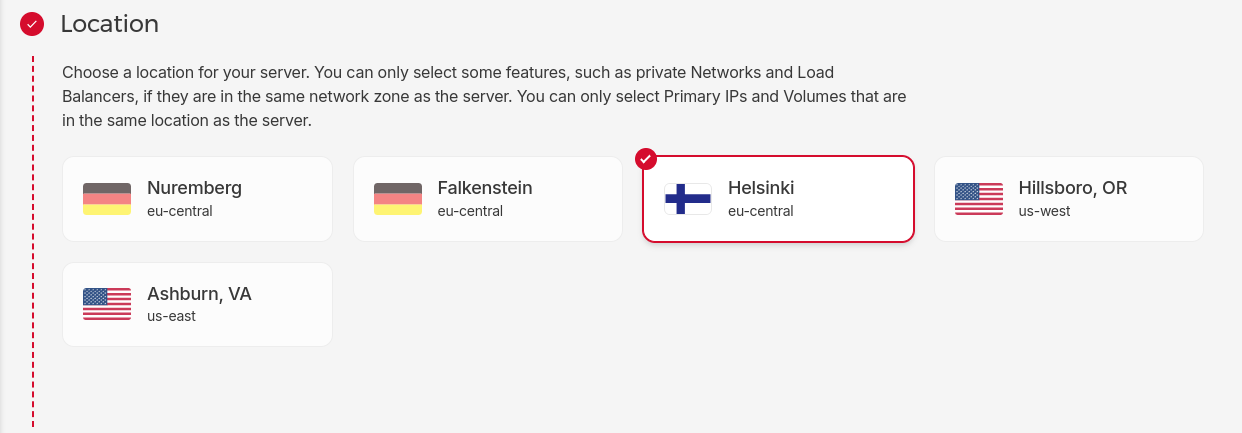
-
Select an Image: ServerAvatar supports both Ubuntu 20.04 and Ubuntu 22.04. Therefore, choose one of these supported operating systems.
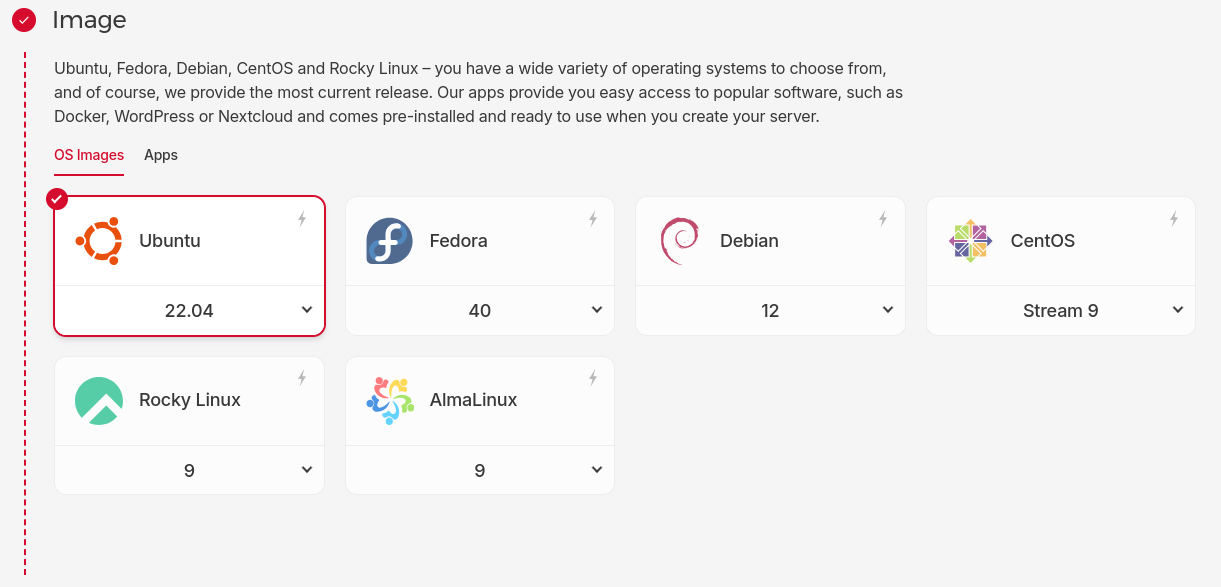
-
Select a Server Type: Hetzner provides various plans with different configurations of CPU, RAM, and storage. Select the plan according to your needs. The minimum requirement is 1GB or more of RAM for better performance and disk space based on the size of your application and its data.
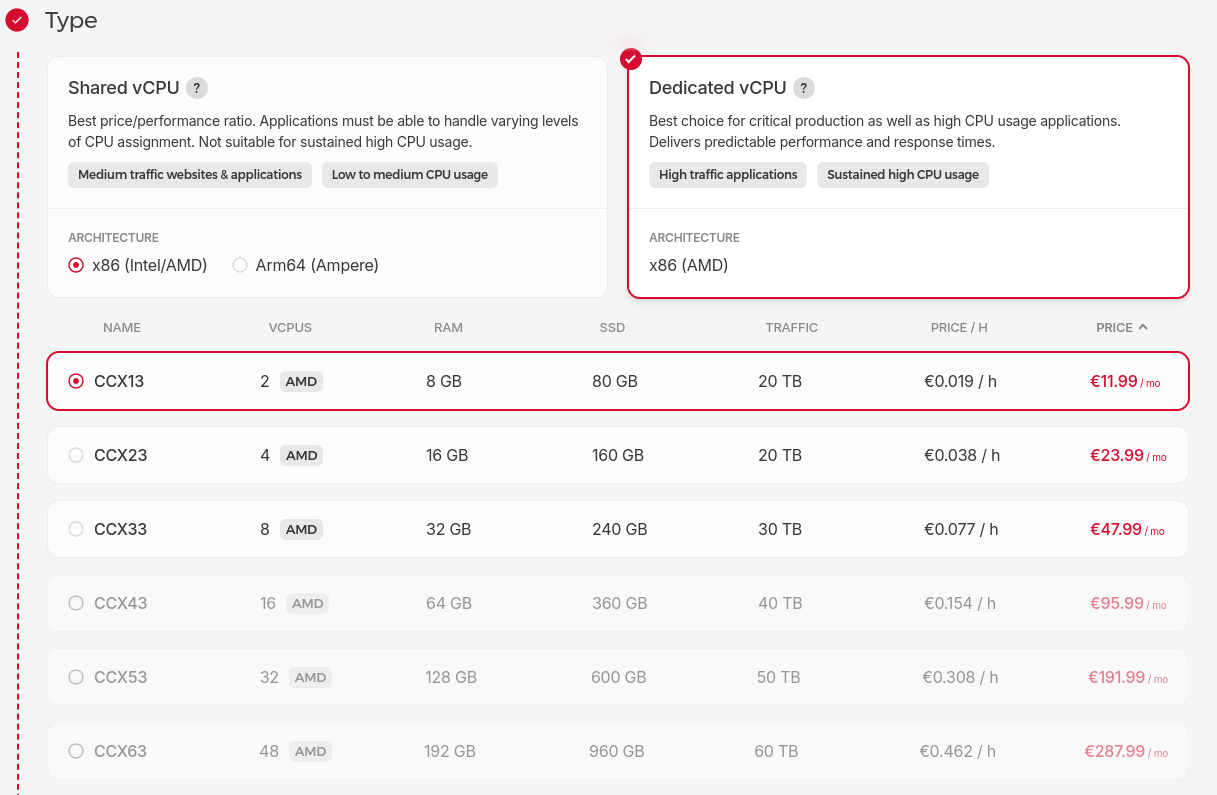
-
Select Networking: Select from three networking options for your server. Private networks allow you to securely connect servers within the same data center without going over the public internet.
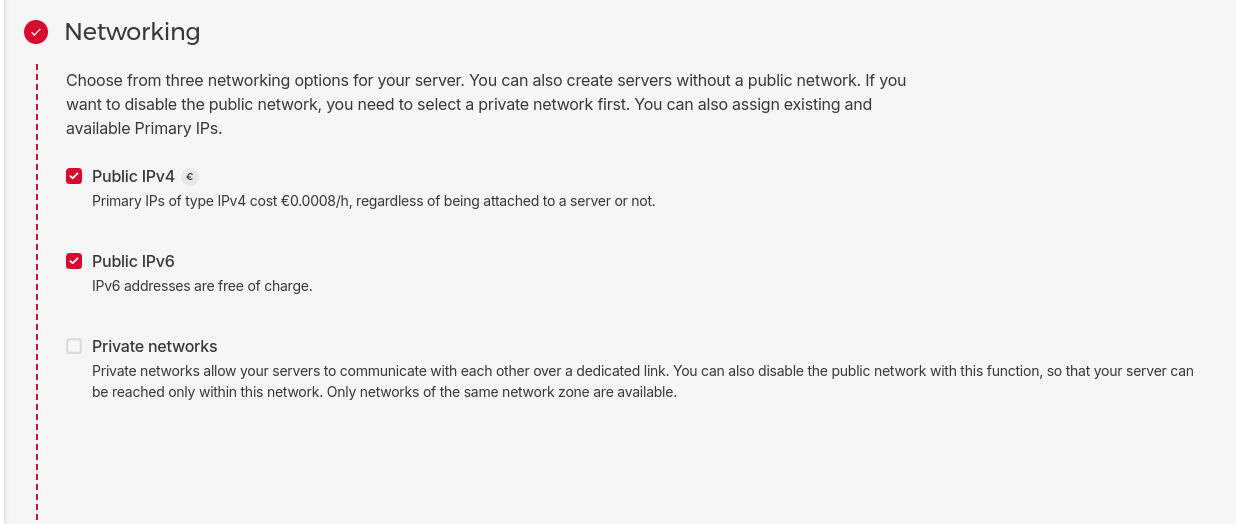
-
SSH Key or Root Password: Select an SSH Key if you want to authenticate with an SSH key. This method is recommended over using a root password for enhanced security. If you choose SSH key authentication, Hetzner will disable password-based authentication by default. Otherwise, you will receive the root password via email.
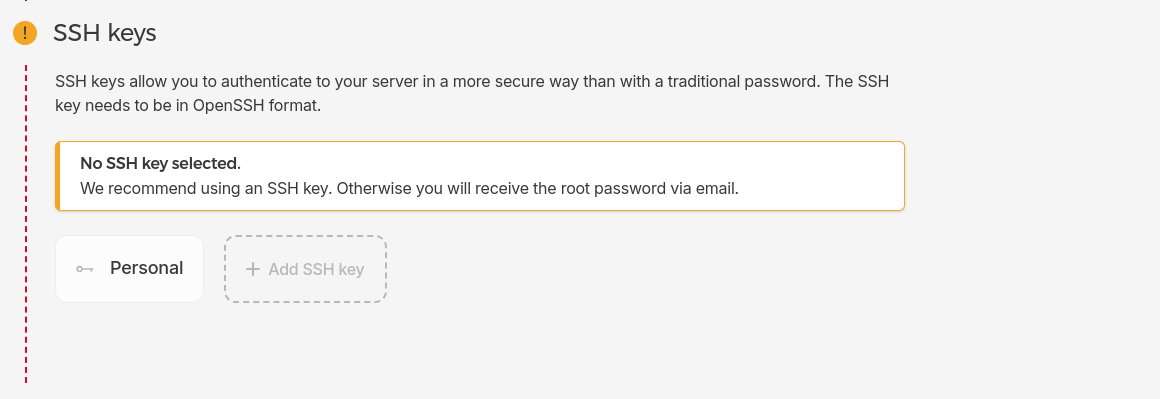
-
Add a Firewall Rule: Configure firewall rules to control incoming and outgoing traffic based on IP addresses, ports, and protocols for improved security.

- Additional Options (Optional): Configure additional options such as Backups, Placement Groups, Volumes, Labels, and Cloud Config as per your Requirements.
-
Give a Server Name: Enter a server name for easy identification.

-
Finalize and Create: Review your configuration settings to ensure that everything is configured correctly. Click on the Create & Buy Now button.9. Finalize and Create: Review your configuration settings to ensure that everything is configured correctly. Click on the Create & Buy Now button.
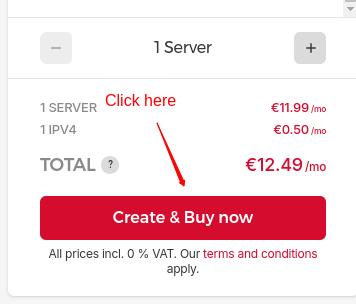
Step 6: Access Your Server
- Once the server is deployed, it will appear on your Hetzner Cloud dashboard. Use the provided IP address and SSH key (if configured) to access your server via SSH. Now, You can connect your Server with ServerAvatar for Server management.
![]()
Initial Server Configuration
The Initial server configuration includes the installation and configuration of various packages required to host your website. Usually, You have to write commands and modify configuration files. Luckily, With ServerAvatar, Your full server configuration and optimization can be automated.
Here are the three ways to automatically configure your server with ServerAvatar.
Connect a server using a direct method
- Login/Register to ServerAvatar account, click the Create button from the right side of the screen, and select Server from the dropdown.
- Select Direct Method in the serve connecting method section.
- Type the Server Name as per your choice.
- Select a Tech Stack as per your need. You can either select Apache, Nginx, OpenLiteSpeed or Node Stack.
- Select a Database: MySQL, MariaDB or MongoDB.
- Enable the toggle if you want to install the latest LTS version of node.js on your server.
- Select a Management plan and click the Connect Now button.
- You’ll see the command on your screen. Login to your server using an ssh connection and execute that command as a root user.
- The server connection process will be started on your ServerAvatar account after executing the command.
Connect a server using integration
- Login/Register to your ServerAvatar account, navigate to the Integration tab from the sidebar of the panel, and access Cloud Platform from the dropdown.
- Now Select a cloud platform you want to link with ServerAvatar.
- The popup form will appear on your screen. Enter details to link your cloud provider account. The integration method is different based on the cloud provider you select.
- You can integrate five different cloud provider platforms with ServerAvatar, which is-
Check the above link of cloud platforms to know more about integrating cloud platforms with ServeAvatar.
Connect a server using commands
Step 1. Login to your server using root user
Once you create a server as per your requirements, connect to your server using an ssh connection and execute the below three commands as a root user in your server console area.
wget https://srvr.so/install
chmod +x install
./install
Step 2. Select a web server
It will ask you which web server you would like to install on your server: Apache, Nginx, OpenLiteSpeed or Node Stack. Type anyone that you would like to install on your server and hit the enter button.
Step 3. Claim your server
Completing the process will give you a link to claim your server.
Open the link on your browser to access the ServerAvatar server panel.
Install and Setup Laravel on Cloud using ServerAvatar
Getting Started With Laravel:
Laravel is a PHP-based Framework that helps you build your application with elegant syntax and provides a variety of features. Laravel provides an amazing developer experience. There are lots of features and tools that are given by Laravel’s environment so that developers can use them to create something new. Laravel is based on MVC (Model, View, Controller) architecture. Laravel is the best choice for small or large projects and full-stack web applications.
Key Features:
- Open Source: Laravel is open-source, so you have the flexibility to build applications according to your needs.
- Extensible: Laravel offers the capability to enhance your web application through a wide range of features and tools.
- Developer-Friendly: Laravel provides an expressive framework with elegant syntax and a scalable environment, and it speeds up your development while maintaining ease of use.
- Secure: Laravel provides various Authentication processes and middleware to enhance the security of your web application.
Let's begin by creating the application.
Step 1: Create a GitHub application
Start by creating a GitHub Application using ServerAvatar. Go to the Applications tab on the server panel and click on the Create button as shown in the image below.
![]()
On the following screen, fill in the Application details, including:
- Application Name: enter your Application Name.
- Select Domain: Select between a Test Domain or a Primary Domain as per your requirements.
- Enter Domain: Enter your Application Domain.
- Method: Select Git as your application method.
- Service Provider: Select GitHub as service provider for cloning the repository.
- Repository Type: Public
- Clone HTTPS URL: https://github.com/laravel/laravel.git
-
Branch:
master -
Deployment Script:
composer update(to update the composer after cloning)
![]()
Now, your Application is ready. You can see your Application in the Dashboard.
![]()
Step 2: Create a Database
To create a Database that stores your confidential data, Go to the Dashboard and click on the Databases option. Enter Your Database name and just hit on the “Create a Database” button as shown in the image below.
![]()
After successfully creating a Database, you can see your Database in the Databases Dashboard.
![]()
Step 3: SSH Setup and env Configuration
- First, go to the Application Dashboard and enable SFTP/SSH Credentials as shown in the below image.
![]()
- After, enabling SFTP/SSH, you can log in to your server. Open a terminal and use the following command:
ssh {username}@{ip} - Replace
{username}with your actual Username and{ip}with your server's IP address. You will be prompted to enter your password. After successful authentication, you will have remote access to your server. - Navigate to your Application Path by running the following command:
cd LaravelApplication/public_html/
![]()
- Next, you need to copy the .env.example file to the .env file.
-
Command for Copy:
cp .env.example .env
![]()
Step 4: Generate App Key
- Next, you need to generate an APP_KEY in your .env file. To generate the key, execute the following command.
-
Command:
php artisan key:generate
![]()
Step 5: Configure .env file
- Navigate to the Application Panel access the FIle Manager option and open the public_html folder. Then, click on the Show Hidden Files option.
![]()
- Open the .env file by clicking on it.
![]()
- As shown in the image below, change the APP_URL from
http://localhosttoyour-application-domainin the .env file. - Edit and update your application's database details.
![]()
-
Note: If the details section in your database details starts with "#", please remove the # from the starting of the line, as it is treated as a comment and may prevent it from functioning properly.
-
To find your database credentials, navigate to the Databases section in the server panel and click on the manage users icon next to the database you have set up for your application.
![]()
- You can see your Database credentials as shown in the image below.
![]()
Step 6: Migrate Database Tables
- Now, you have to migrate your Database tables. Execute the following command.
-
Command:
php artisan migrate
![]()
Step 7: Update Custom Webroot
- To run your application on a server, you must set your Custom Webroot to public. To update this setting, navigate to the Settings option in the sidebar of your application.
- Add public in the Custom Webroot Section and click on Update Custom Webroot as shown in the below image.
![]()
Step 8: Access Laravel
- Now, to access Laravel, open your web browser and enter your site's domain.
-
Example:
http://lara.satesting1.click -
For instance:
http://your-application-domain
-
Example:
![]()
Conclusion :
- Deploying your PHP Laravel application with ServerAvatar simplifies the entire process, ensuring a smooth and efficient setup. Each step is straightforward and well-guided, from creating the application and database to configuring server settings and migrating database tables.
- Laravel's robust features, combined with ServerAvatar’s user-friendly interface, make it an excellent choice for developers looking to deploy applications quickly and securely.
- Following the detailed steps outlined in this guide, you can confidently launch your Laravel application and take advantage of the powerful tools and environment both Laravel and ServerAvatar provide.